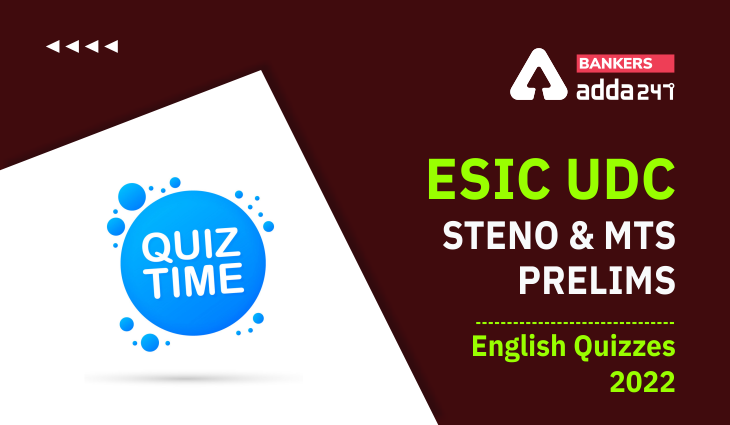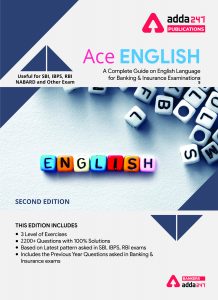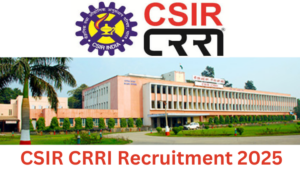Directions (1-10): Read the following passage carefully and answer the questions given below it. Certain words/phrases are given in bold to help you to locate them while answering some of the questions.
We have just heard that the State Literacy Mission in Kerala has won this year’s UNESCO award for ‘Continuing education’. Yet we need to do some close introspection of how the programme of eradicating illiteracy is going, particularly in Kerala, which was a forerunner in completely wiping out illiteracy in the districts of Ernakulam and Kottayam.
As part of the Total Literacy Programme, the Kerala People’s Science Movement (KSSP) organised a mass campaign to reach 100 per cent literacy in Ernakulam district. They were able to do this with a lot of volunteers through songs, street plays, public meetings, wall posters and a massive procession to converge at Ernakulam on January 26, 1989. The volunteers came from among teachers, mostly, and they used participatory methods for rousing people and creating an exciting movement. They handled 135,000 of Ernakulam’s 174,000 illiterate people to read and write and do simple arithmetic and understand elements of health, sanitation and inoculation. Kottayam was the first town in India which achieved total literacy because of the efforts of the young collector who pursued several to take part in the thrilling campaign to make the effort successful. ‘Total literacy’ came to Kerala in 1991. Alas! today, we have lost ground to Mizoram, which ranks as the number one State.
In view of the commission appointed by the UNESCO, whose report “LEARNING TO BE” was published in 1996, “while education is an ongoing process of improving knowledge and skills, it is also perhaps primarily an exceptional means of bringing about personal development and building relationships among individuals, groups and nations.” It was not said in jest when, some years ago, our programme in Kerala was at its peak, that many mothers-in-law and daughters-in-law had patched up their differences after attending the classes such a difference can learning make!
In Kerala, we have had a historical heritage whereby education was encouraged by the royal family, particularly women’s education. Successive governments of different hues kept this tradition intact and allotted a third of the budget to education, along with investments in other spheres of human development such as access to health and social services. Over the years, the ‘physical quality of life’ index in Kerala has been the highest in the country despite our being at the bottom of the heap in terms of per capita income and nutritional levels. In Kerala, the KSSP and the Kerala Association for Non-Formal Education (Kanfed) have had a large role to play in promoting awareness, literacy, education and the reading habit among people through a system of mobile libraries, all without much fanfare or money. In a sense, education was taken to the remotest corners, and literally to the people’s doorstep. In spite of this, there are still pockets of illiteracy which need to be concentrated on if we must reach the goal of cent per cent literacy.
Q1. What method did the KSSP employ to achieve cent per cent literacy in Ernakulam?
(a) Their volunteers organised mass campaign through songs, plays, public meetings and various other means to create awareness among people.
(b) Their volunteers went door-to-door and told the people about the advantage of literacy.
(c) Audio-video systems were used to focus on the utility of literacy.
(d) Volunteers of KSSP organised several workshops in each and every locality of Ernakulam on the “necessity of literacy.”
(e) None of these
Q2. The Kerala State Literacy Mission has been chosen for this year’s UNESCO award for
(a) adult education
(b) continuing education
(c) child education
(d) correspondence education
(e) women education
Q3. What was the result of the awareness campaign organised by the volunteers of KSSP in Ernakulam district?
(a) Many people knew the importance of awareness camp and thus decided to enrol themselves as permanent volunteer of KSSP to make others aware
(b) Once the awareness camp became successful, many more such camps were organised in different parts of the district spreading the light of awareness.
(c) After the awareness camp, most of the illiterate people were able to read, write, do simple sums and understand the necessity of primary health and sanitation.
(d) Media highlighted the awareness camp and then the Govt also took serious concern regarding the camp’s approach by funding it suitably.
(e) The physical quality of life of the people developed due to their awareness regarding health, nutrition and education.
Q4. How did the young collector make his effort successful in bringing hundred per cent literacy in Kottayam?
(a) He made it necessary for all to attend the “literacy workshop” under Adult Education Scheme of Govt.
(b) He brought the awareness of literacy through songs, street plays, posters and public meetings.
(c) He took the help of local teachers, who went door-to-door to bring mass awareness regarding illiteracy and organised evening schools for the downtrodden.
(d) Due to his tireless effort he was able to convince people to take part in the campaign against illiteracy.
(e) He lured the poor to attend the awarness camp by giving them attractive gifts, money and food items.
Q5. According to the passage, what difference can learning make?
(a) It makes the people conscious of their rights.
(b) It ends up the differences and tensions between/ among people.
(c) A literate man can behave well with others.
(d) It teaches people the art of earning bread and butter.
(e) None of these
Directions (6-8): Choose the alternative which is most nearly the SAME in meaning as the word in capitals below, as used in the passage.
Q6. INTROSPECTION
(a) Confession
(b) Scrutiny
(c) Self-examination
(d) Discrimination
(e) Inspection
Q7. CONVERGE
(a) Diverge
(b) Concentrate
(c) Unite
(d) Meet
(e) Focus
Q8. INOCULATION
(a) Infection
(b) Vaccination
(c) Penetration
(d) Implantation
(e) Immunization
Directions (9-10): Choose the alternative which is most nearly the OPPOSITE in meaning to the word in capitals below, as used in the passage.
Q9. THRILLING
(a) Dull
(b) Enjoyable
(c) Exciting
(d) Sensation
(e) Shivering
Q10. PROMOTING
(a) Deteriorating
(b) Improving
(c) Encouraging
(d) Raising
(e) Aiding
Directions (11-15): Rearrange the following sentences to form a meaningful paragraph and answer the questions given below:
(A) We must explore new methods of boosting agricultural development and grow more food.
(B) The scientists should be encouraged to contribute.
(C) Food can also be had by import.
(D) The most important factor in any planning for India’s development and economic uplift is that of turning a hungry, discontented people into a happy well-fed one.
(E) Whatever be the way and means, India must feed its hungry millions.
(F) They should be given due scope for carrying on experiments and researches.
(G) The problem, therefore, reduces itself to one of agricultural development.
Q11. Which of the following is the fourth sentence in the paragraph?
(a) A
(b) D
(c) E
(d) G
(e) F
Q12. Which of the following is fifth sentence in the paragraph?
(a) G
(b) A
(c) D
(d) C
(e) E
Q13. Which of the following is the third sentence in the paragraph?
(a) F
(b) A
(c) G
(d) D
(e) E
Q14. Which of the following is the last sentence in the paragraph?
(a) F
(b) C
(c) D
(d) B
(e) G
Q15. Which of the following is the second sentence in the paragraph?
(a) B
(b) E
(c) C
(d) G
(e) F
Solutions
S1. Ans. (a)
Sol. Read the first sentence of the second paragraph- “As part of the Total Literacy Programme, the Kerala People’s Science Movement (KSSP) organised a mass campaign to reach 100 per cent literacy in Ernakulam district.”
S2. Ans. (b)
Sol. Read the first sentence of the first paragraph-“We have just heard that the State Literacy Mission in Kerala has won this year’s UNESCO award for ‘Continuing education’ .”
S3. Ans. (c)
Sol. Read the second paragraph of the passage-“They handled 135,000 of Ernakulam’s 174,000 illiterate people to read and write and do simple arithmetic and understand elements of health, sanitation and inoculation.”
S4. Ans. (d)
Sol. Read the second paragraph of the passage- “Kottayam was the first town in India which achieved total literacy because of the efforts of the young collector who pursued several to take part in the thrilling campaign to make the effort successful.”
S5. Ans. (b)
Sol. Read the third paragraph of the passage- “It was not said in jest when, some years ago, our programme in Kerala was at its peak, that many mothers-in-law and daughters-in-law had patched up their differences after attending the classes such a difference can learning make!.”
S6. Ans. (c)
Sol. The word INTROSPECTION means the examination or observation of one’s own mental and emotional processes; self-analysis. So Self-examination is the word most similar in the meaning.
S7. Ans. (d)
Sol. The word CONVERGE means, (of lines) tend to meet at a point. So Meet is the word most similar in the meaning
S8. Ans. (b)
Sol. The word INOCULATION means immunization, vaccination, vaccine, injection.
S9. Ans. (a)
Sol. The word THRILLING means causing excitement and pleasure; exhilarating. So the word DULL is most nearly the opposite in meaning.
S10. Ans. (a)
Sol. The word PROMOTING means support or actively encourage (a cause, venture, etc.); further the progress of. So the word DETERIORATING is most nearly the opposite in meaning.
S11. Ans. (a)
Sol. The correct sequence to form a meaningful paragraph is DEGACBF.
S12. Ans. (d)
Sol. The correct sequence to form a meaningful paragraph is DEGACBF.
S13. Ans. (c)
Sol. The correct sequence to form a meaningful paragraph is DEGACBF.
S14. Ans. (a)
Sol. The correct sequence to form a meaningful paragraph is DEGACBF.
S15. Ans. (b)
Sol. The correct sequence to form a meaningful paragraph is DEGACBF.
Click Here to Register for Bank Exams 2022 Preparation Material





 GA Capsule for SBI Clerk Mains 2025, Dow...
GA Capsule for SBI Clerk Mains 2025, Dow...
 The Hindu Review October 2022: Download ...
The Hindu Review October 2022: Download ...
 Delhi CSIR CRRI Recruitment 2025 Notific...
Delhi CSIR CRRI Recruitment 2025 Notific...







